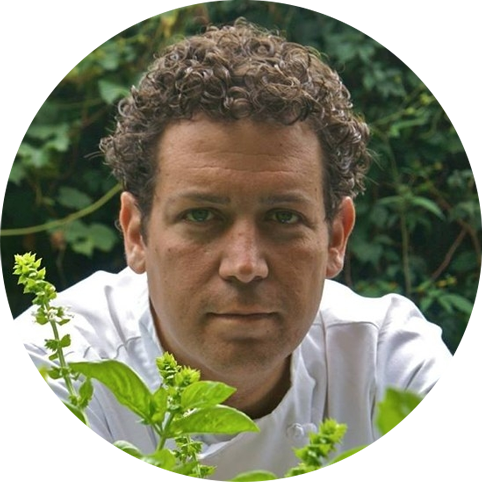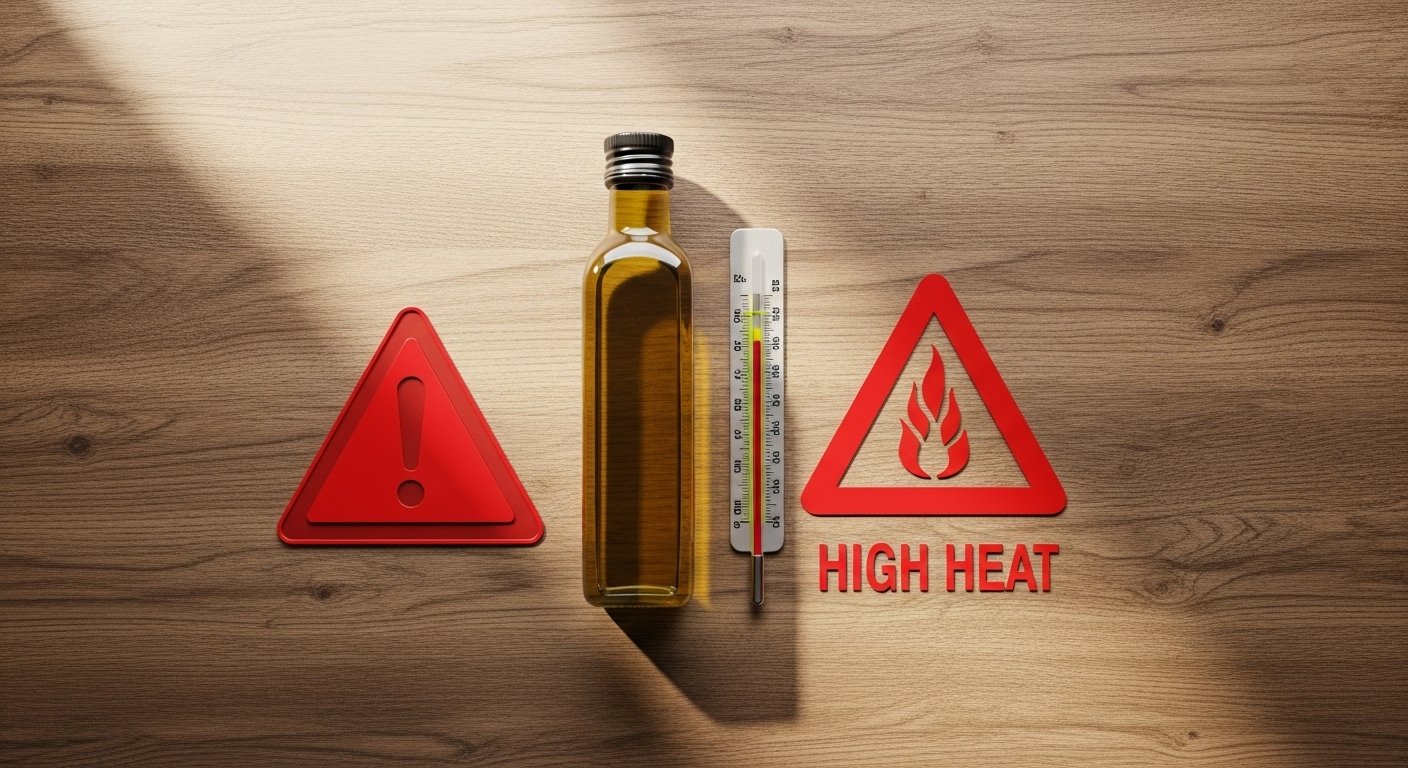1) Very high pan temps push EVOO past its comfort zone
- Smoke point vs. real pan temps. Good EVOO typically smokes around ~190–210 °C (375–410 °F); refined/light olive oil can reach ~240 °C (465 °F). Serious hard-searing and restaurant-style wok work often runs 230–260 °C (450–500 °F) at the pan surface—hot enough to drive EVOO into visible smoking and faster decomposition. Olive Oil TimesUC Food QualitySerious EatsThermoWorks
- Once oil is smoking, triglycerides and antioxidants are breaking down faster and irritating aldehydes (like acrolein) start forming—one reason pros choose higher-smoke-point, neutral oils for extreme sears. Olive Oil Times
Takeaway: For cast-iron steak sears or full-blast wok-hei, skip EVOO (or use refined olive oil/avocado/high-oleic oils instead). For sautéing/roasting under ~205 °C/400 °F, quality EVOO is fine—and often ideal. Harvard HealthUC Food Quality
2) Prolonged or repeated high-heat frying strips EVOO’s protective polyphenols and raises polar compounds
- Phenolic antioxidants (hydroxytyrosol derivatives) drop 40–60% in just 10 min at 180 °C during the first frying cycle; after six cycles, only ~10% remain. Fewer antioxidants means faster oxidation and more off-flavors. PubMedPMC
- Deep-frying degrades all oils over time, measured as total polar compounds (TPC); many jurisdictions treat ~25% TPC as the discard limit for used frying oils. EVOO resists this better than most, but it still crosses the limit with extended/repeated frying. (One study found olive oils lasted 24–27 h vs. a veg-oil blend at ~15 h before hitting ~25% TPC—but both ultimately failed). ScienceDirectResearchGatejfda-online.com
- Heating edible oils at frying temps generates toxic α,β-unsaturated aldehydes; amounts increase with time/temperature exposure. (Again, EVOO performs better than most seed oils, but the compounds still rise if you hold the heat long enough.) ScienceDirect
Takeaway: EVOO isn’t the best pick for commercial-style, all-day frying or repeated reuse. For occasional home frying it can be excellent, but don’t re-use it many times and keep temps controlled. ScienceDirect
3) Storage abuse (light + oxygen + warm temps) makes EVOO break down before it hits the pan
- Exposure to light and oxygen accelerates rancidity, raises free fatty acids, and depletes antioxidants; higher storage temperatures speed it all up. Use dark glass, tight closures, and cool storage. PMCOlive Oil Times
- Even modest headspace oxygen reduces shelf life; keeping oxygen under ~5% markedly improves stability. ScienceDirect
Takeaway: A mistreated bottle will smoke sooner and degrade faster in the pan. Treat EVOO like wine: dark, cool, capped.
What’s actually happening (the chemistry)
- Oxidation pathways
- Autoxidation (with triplet oxygen) and photo-oxidation (with singlet oxygen) attack unsaturated bonds. Heat, light, metals, and oxygen accelerate these reactions, producing peroxides → aldehydes/ketones → rancid flavors. Wiley Online Library
- Autoxidation (with triplet oxygen) and photo-oxidation (with singlet oxygen) attack unsaturated bonds. Heat, light, metals, and oxygen accelerate these reactions, producing peroxides → aldehydes/ketones → rancid flavors. Wiley Online Library
- Antioxidant burn-off
- EVOO’s phenolics (e.g., hydroxytyrosol derivatives) protect the oil and your food. High, sustained heat consumes them; as they decline, the oil’s oxidative stability drops. Quantitatively: ~50–60% loss in just 10 min @ 180 °C; ~90% gone after several cycles. PubMed
- EVOO’s phenolics (e.g., hydroxytyrosol derivatives) protect the oil and your food. High, sustained heat consumes them; as they decline, the oil’s oxidative stability drops. Quantitatively: ~50–60% loss in just 10 min @ 180 °C; ~90% gone after several cycles. PubMed
- By-product accumulation
- With time/heat, oils accumulate total polar compounds (TPC) and aldehydes; both correlate with off-flavors and potential toxicity at high levels. That’s why many food codes cap TPC near 25% for used frying oil. jfda-online.comScienceDirect
- With time/heat, oils accumulate total polar compounds (TPC) and aldehydes; both correlate with off-flavors and potential toxicity at high levels. That’s why many food codes cap TPC near 25% for used frying oil. jfda-online.comScienceDirect
Where the “never cook with olive oil” claim came from (and why it’s too simple)
- Some messaging focuses on EVOO’s lower smoke point than refined, neutral oils and on the fact that heat, oxygen, and light do degrade it—true in isolation. But multiple controlled studies and expert groups also show EVOO is among the most stable oils when heated because of its monounsaturated profile and phenolics. Translation: “don’t cook with olive oil” is an over-correction. UC Food QualityNorth American Olive Oil Association
- Authoritative consumer/academic guidance (Harvard, UC Davis Olive Center) explicitly notes EVOO is excellent for most cooking, with caution only at very high heat or prolonged/repeated frying. Harvard HealthUC Food Quality
Practical guidance you can use (for staff scripts + guest education)
- Match oil to the job
- High-heat sear/wok-hei (≥230 °C/450 °F): use refined olive oil, avocado, high-oleic peanut/sunflower, or beef tallow/ghee depending on flavor. Save EVOO for finishing or moderate-heat cooking. Serious Eats
- Sauté/roast ≤200 °C/392 °F & shallow-fry: high-quality EVOO is great—and flavor-positive. Harvard HealthUC Food Quality
- High-heat sear/wok-hei (≥230 °C/450 °F): use refined olive oil, avocado, high-oleic peanut/sunflower, or beef tallow/ghee depending on flavor. Save EVOO for finishing or moderate-heat cooking. Serious Eats
- Keep temps honest
- If oil smokes, it’s too hot—reduce heat or switch oils. (Smoking = faster breakdown and more irritant aldehydes.) Olive Oil Times
- If oil smokes, it’s too hot—reduce heat or switch oils. (Smoking = faster breakdown and more irritant aldehydes.) Olive Oil Times
- Don’t re-use EVOO too many times for frying
- Phenolics fall fast; TPCs rise. Discard oil well before ~25% TPC if you don’t have a meter—use sensory cues (darkening, viscosity, acrid smell) and a conservative reuse policy. PubMedjfda-online.com
- Phenolics fall fast; TPCs rise. Discard oil well before ~25% TPC if you don’t have a meter—use sensory cues (darkening, viscosity, acrid smell) and a conservative reuse policy. PubMedjfda-online.com
- Store it like you care
- Dark bottle, tight cap, cool pantry (not next to the range). Buy in sizes you’ll finish in 1–3 months. PMC
- Dark bottle, tight cap, cool pantry (not next to the range). Buy in sizes you’ll finish in 1–3 months. PMC
Selected research & references (curated)
Heat stability / frying performance
- Casal, S. et al. “Olive oil stability under deep-frying conditions.” Food Chem Toxicol (2010): Olive oils resisted degradation longer than a veg-oil blend, but still hit discard thresholds with extended/repeated frying. ScienceDirect
- Gómez-Alonso, S. et al. “Changes in phenolic composition and antioxidant activity of virgin olive oil during frying.” J Agric Food Chem (2003): 50–60% phenolic loss after 10 min at 180 °C; ~90% loss after multiple cycles. PubMed
- Guillén, M.D. & Goicoechea, E. “Toxic oxygenated α,β-unsaturated aldehydes in oils at frying temperature.” Food Chem (2012): aldehyde formation increases with frying time/temperature. ScienceDirect
- Ambra, R. et al. “Effects of olive-oil cooking on phenolics” (review). Foods (2022): summarizes degradation/migration of phenolics with heating/cooking. PMC
Smoke point & practical cooking temps
- UC Davis (UC Food Quality/Olive Center): EVOO smoke points ~175–240 °C depending on grade/quality; EVOO is excellent for cooking due to heat-resistant antioxidants. UC Food Quality
- Olive Oil Times explainer: filtered EVOO smoke point ≈ 207 °C (405 °F); smoking signals faster breakdown and acrolein formation. Olive Oil Times
- Serious Eats smoke-point table (refined olive oil ~240 °C/465 °F) for context against searing/wok temperatures. Serious Eats
- ThermoWorks searing guide: typical sear surfaces 204–232 °C (400–450 °F), with many home methods pushing higher. ThermoWorks
Storage: light/oxygen/heat effects
- Sanmartin, C. et al. “Effects of packaging and storage temperature on EVOO shelf-life.” Foods (2018): higher temp/light/oxygen accelerate rancidity and antioxidant loss. PMC
- Olive Oil Times summary of research on light/oxygen/heat harm to olive oil quality. Olive Oil Times
- Iqdiam, B.M. et al. “Influence of headspace oxygen on oil quality/shelf life.” J Stored Prod Res (2020): low headspace O₂ markedly improves stability. ScienceDirect
Big-picture perspective (balance)
- Harvard T.H. Chan School: EVOO is a healthy, versatile cooking oil; most home cooking won’t exceed smoke points; problems arise at very high heat. Harvard Health
Bottom line for your white paper / staff training
- If you’re hard-searing at 450–500 °F or chasing wok-hei, EVOO (especially extra-virgin) is not the best tool—use a higher-smoke-point, neutral oil or refined olive oil. Chemistry and sensory outcomes agree. ThermoWorksSerious Eats
- If you’re sautéing, roasting ≤ 400 °F, or shallow-frying briefly, well-stored EVOO is stable and excellent—and brings flavor and nutrition. Harvard HealthUC Food Quality
- Don’t re-use EVOO for many fry cycles; phenolics crash and polar compounds/aldehydes rise with time/heat. PubMedjfda-online.comScienceDirect
- Protect it from light/oxygen/heat so it doesn’t arrive at the pan half-degraded. PMC
If you want, I can turn this into a one-pager chart (staff cheat-sheet) + a longer blog section with these citations embedded and your voice woven through.








